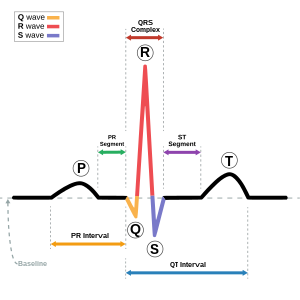Sinus rhythm

Sinus rhythm is a term used in medicine to describe the normal beating of the heart, as measured by an electrocardiogram (ECG). It has certain generic features that serve as hallmarks for comparison with normal ECGs.
Sinus rhythm is characterized by a usual rate of anywhere between 50-110 bpm. Every QRS complex is preceded by a P wave but not every P wave must be followed by a QRS as occurs if there is second or third degree AV block. The P wave morphology and axis must be normal and the PR interval will usually be >120 ms or greater.
There are typically five distinct waves (identified by the letters P, Q, R, S, and T) in a single beat of the heart in sinus rhythm, and they occur in a specific order, over specific periods of time, with specific relative sizes. While there is a significant range within which variations in rhythm are considered normal, anything that deviates from sinus rhythm by more than a certain amount may be indicative of heart disease.
In normal sinus rhythm, electrical impulses from the SA node travel to the AV node with successful contraction of the two atria. The electrical impulses from the AV node successfully contract the ventricles. On the ECG, there are normal PQRST elements with no evidence of arrhythmia, tachycardia, or bradycardia.
